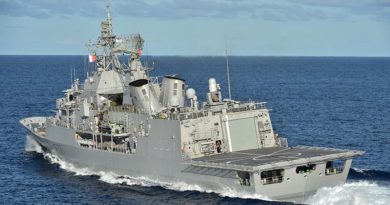Embeds to contribute to regional deterrence

Five Australian Army personnel have headed to Hawaii to embed with the US Army’s 3rd Multi-Domain Task Force (3rd MDTF).
CAPTION: Australian Army officer Lieutenant Colonel Owain Griffiths is one of five Australian Army personnel posted to the United States Army’s 3rd Multi-Domain Task Force from mid-2024. Story by Lieutenant Colonel Carrie Robards.
It is the newest multi-domain task force in the US Army, in support of the US Army Pacific, and is designed to deploy long-range precision effects into the Indo-Pacific region across a range of domains in an anti-access/area denial role.
To help accelerate the development of Australia’s long-range strike capabilities, Australian Army personnel now have the opportunity to work with their American counterparts for an extended period.
This posting falls under the Military Personnel Exchange Program (MPEP), which enables Australian personnel to integrate into partner nation units to contribute to a depth of partnership, integration and understanding that wouldn’t be achievable in the same way through short-term exchanges or exercises.
The soldiers selected for service in the task force have a range of corps backgrounds and experiences including targeting, air defence, long-range fires and logistics.
One of the embeds is Lieutenant Colonel Owain Griffiths, who was previously posted to the ADF Multi-Domain Strike Program at Land Capability Division.
Lieutenant Colonel Griffiths explained the intent was to establish an enduring relationship that developed collective capabilities to conduct multi-domain operations.
“We are very proud to have the opportunity to work with our partners and to contribute to the security of our region,” he said.
“While the posting [didn’t] officially start until June, the embeds had gained a head start, working closely with the 3rd MDTF on Project Convergence Capstone Four in March.
“All of the embed team have been very fortunate to have the opportunity to participate in Project Convergence and to work directly alongside the team from the 3rd MDTF.”
Project Convergence is a US-led campaign of learning through persistent experimentation, designed to advance and integrate technology across all warfighting domains.
“During this iteration of Project [Convergence], I worked as a liaison officer and focused on learning as much as possible from the 3rd MDTF team,” Lieutenant Colonel Griffiths said.
“I learned how the MDTF uses technology and their people to make sense of large amounts of information, develop a plan and coordinate land, maritime, air, space and cyberspace capabilities to engage and destroy targets at long range.
“We’ve also really enjoyed the opportunity to meet key leaders from the 3rd MDTF, to innovate together during the activity, and to set the conditions for success.”
Commander 3rd MDTF Colonel Michael Rose explained they were tasked with delivering long-range fire, sensing and effects in support of US joint forces as well as allies and partners.
“Australia is a key ally and we are working closely alongside the ADF as they continue to develop and implement their multi-domain strike doctrine, which directly complements US Army multi-domain operations concepts,” he said.
“Project Convergence Capstone 4 provided us an ability to work side by side with our Australian Army counterparts to tackle the challenges inherent to multi-domain operations.”
Project Convergence Capstone Four was the first time working with the 3rd MDTF for many, but the first time Lieutenant Colonel Griffiths met the US team was in Australia last year.
“I first met the 3rd MDTF team during Exercise Talisman Sabre 23, and was immediately impressed by their professionalism and capability,” he said.
“We have a lot of similar processes and methods, but the most striking difference is the scope and scale of operations that the US are able to achieve.
“The speed and scale that the US have been able to generate in establishing their multi-domain task forces, and integrating emerging technologies into them has been particularly impressive.
“I was delighted at the opportunity to be able to work with them more directly.”
Colonel Rose agreed that it was the similarities that enabled the US and ADF to work so closely together.
“The ADF sees the current and future battlefield like we do – as one that requires synchronisation of all domains to deliver effects that provide an advantage for friendly forces,” Colonel Rose said.
“One of the greatest advantages the US has is its partners and allies, and having the opportunity to integrate ADF soldiers into the 3rd MDTF formation is key to creating and maintaining technical, procedural and human multi-domain interoperability.
“We look forward to welcoming these soldiers into 3rd MDTF and learning everything we can from their perspective and expertise as well as sharing our lessons learned.
“By working together we can both accelerate our capability and capacity to conduct operations.”
.
.

.
.





